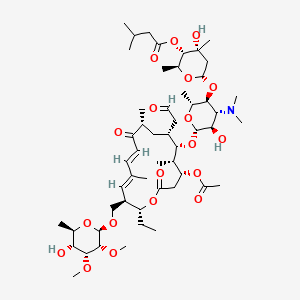
Sulfadiazina
Descripción general
Descripción
La sulfadiazina es un antibiótico sulfonamida ampliamente utilizado en el tratamiento de diversas infecciones bacterianas. Es particularmente eficaz contra las infecciones del tracto urinario, el tracoma y el chancroide . La this compound también se utiliza en combinación con pirimetamina para tratar la toxoplasmosis en pacientes con síndrome de inmunodeficiencia adquirida y en recién nacidos con infecciones congénitas . Este compuesto es conocido por su capacidad para inhibir la síntesis de ácido fólico en las bacterias, evitando así su crecimiento y proliferación .
Aplicaciones Científicas De Investigación
La sulfadiazina tiene una amplia gama de aplicaciones de investigación científica:
Química: Utilizada como reactivo en la síntesis de otros derivados de sulfonamida.
Biología: Empleada en estudios que involucran resistencia bacteriana y el desarrollo de nuevos antibióticos.
Industria: Aplicada en la producción de medicamentos veterinarios y como conservante en ciertas formulaciones.
Mecanismo De Acción
La sulfadiazina actúa inhibiendo la enzima bacteriana dihidrofolato reductasa . Esta enzima es crucial para la síntesis de ácido fólico, que es esencial para el crecimiento y la replicación bacterianos . Al inhibir competitivamente esta enzima, la this compound evita que las bacterias sinteticen ácido fólico, lo que lleva a su muerte eventual .
Métodos De Preparación
Rutas sintéticas y condiciones de reacción
La síntesis de sulfadiazina generalmente comienza con la acetilación de derivados de anilina utilizando anhídrido acético para formar derivados de acetanilida . Estos derivados se hacen reaccionar luego con ácido clorosulfónico para producir cloruro de 4-acetilaminobencenosulfonilo . En paralelo, la 2-aminopirimidina se prepara haciendo reaccionar tetrametoxipropano con una sal de guanidina . El paso final implica hacer reaccionar cloruro de 4-acetilaminobencenosulfonilo con 2-aminopirimidina, seguido de hidrólisis con hidróxido de sodio para producir this compound .
Métodos de producción industrial
La producción industrial de this compound sigue rutas sintéticas similares pero a mayor escala. El proceso implica un control estricto de las condiciones de reacción para garantizar un alto rendimiento y pureza. El uso de reactores automatizados y sistemas de flujo continuo ayuda a mantener la calidad y la eficiencia consistentes en la producción .
Análisis De Reacciones Químicas
Tipos de reacciones
La sulfadiazina experimenta diversas reacciones químicas, incluidas la oxidación, la reducción y la sustitución . El compuesto contiene dos grupos reactivos: una amina aromática y un grupo sulfonamida, que participan en estas reacciones .
Reactivos y condiciones comunes
Reducción: La reducción de this compound se puede lograr utilizando agentes reductores como el borohidruro de sodio.
Productos principales
Los principales productos formados a partir de estas reacciones incluyen diversos derivados de this compound, que pueden utilizarse posteriormente en aplicaciones farmacéuticas .
Comparación Con Compuestos Similares
Compuestos similares
Sulfametoxazol: Otro antibiótico sulfonamida utilizado en combinación con trimetoprima para tratar diversas infecciones bacterianas.
Sulfisoxazol: Utilizado para tratar infecciones del tracto urinario y otras infecciones bacterianas.
Sulfadiazina de plata: Un agente tópico utilizado en el tratamiento de quemaduras e infecciones de heridas.
Unicidad
La this compound es única debido a su actividad antibacteriana de amplio espectro y su capacidad para utilizarse en combinación con otros fármacos como la pirimetamina para el tratamiento de infecciones específicas como la toxoplasmosis . Su eficacia tanto en la medicina humana como veterinaria destaca aún más su versatilidad .
Propiedades
IUPAC Name |
4-amino-N-pyrimidin-2-ylbenzenesulfonamide | |
|---|---|---|
| Source | PubChem | |
| URL | https://pubchem.ncbi.nlm.nih.gov | |
| Description | Data deposited in or computed by PubChem | |
InChI |
InChI=1S/C10H10N4O2S/c11-8-2-4-9(5-3-8)17(15,16)14-10-12-6-1-7-13-10/h1-7H,11H2,(H,12,13,14) | |
| Source | PubChem | |
| URL | https://pubchem.ncbi.nlm.nih.gov | |
| Description | Data deposited in or computed by PubChem | |
InChI Key |
SEEPANYCNGTZFQ-UHFFFAOYSA-N | |
| Source | PubChem | |
| URL | https://pubchem.ncbi.nlm.nih.gov | |
| Description | Data deposited in or computed by PubChem | |
Canonical SMILES |
C1=CN=C(N=C1)NS(=O)(=O)C2=CC=C(C=C2)N | |
| Source | PubChem | |
| URL | https://pubchem.ncbi.nlm.nih.gov | |
| Description | Data deposited in or computed by PubChem | |
Molecular Formula |
C10H10N4O2S | |
| Source | PubChem | |
| URL | https://pubchem.ncbi.nlm.nih.gov | |
| Description | Data deposited in or computed by PubChem | |
DSSTOX Substance ID |
DTXSID7044130 | |
| Record name | Sulfadiazine | |
| Source | EPA DSSTox | |
| URL | https://comptox.epa.gov/dashboard/DTXSID7044130 | |
| Description | DSSTox provides a high quality public chemistry resource for supporting improved predictive toxicology. | |
Molecular Weight |
250.28 g/mol | |
| Source | PubChem | |
| URL | https://pubchem.ncbi.nlm.nih.gov | |
| Description | Data deposited in or computed by PubChem | |
Physical Description |
Solid | |
| Record name | Sulfadiazine | |
| Source | Human Metabolome Database (HMDB) | |
| URL | http://www.hmdb.ca/metabolites/HMDB0014503 | |
| Description | The Human Metabolome Database (HMDB) is a freely available electronic database containing detailed information about small molecule metabolites found in the human body. | |
| Explanation | HMDB is offered to the public as a freely available resource. Use and re-distribution of the data, in whole or in part, for commercial purposes requires explicit permission of the authors and explicit acknowledgment of the source material (HMDB) and the original publication (see the HMDB citing page). We ask that users who download significant portions of the database cite the HMDB paper in any resulting publications. | |
Solubility |
6.01e-01 g/L | |
| Record name | Sulfadiazine | |
| Source | DrugBank | |
| URL | https://www.drugbank.ca/drugs/DB00359 | |
| Description | The DrugBank database is a unique bioinformatics and cheminformatics resource that combines detailed drug (i.e. chemical, pharmacological and pharmaceutical) data with comprehensive drug target (i.e. sequence, structure, and pathway) information. | |
| Explanation | Creative Common's Attribution-NonCommercial 4.0 International License (http://creativecommons.org/licenses/by-nc/4.0/legalcode) | |
| Record name | Sulfadiazine | |
| Source | Human Metabolome Database (HMDB) | |
| URL | http://www.hmdb.ca/metabolites/HMDB0014503 | |
| Description | The Human Metabolome Database (HMDB) is a freely available electronic database containing detailed information about small molecule metabolites found in the human body. | |
| Explanation | HMDB is offered to the public as a freely available resource. Use and re-distribution of the data, in whole or in part, for commercial purposes requires explicit permission of the authors and explicit acknowledgment of the source material (HMDB) and the original publication (see the HMDB citing page). We ask that users who download significant portions of the database cite the HMDB paper in any resulting publications. | |
Mechanism of Action |
Sulfadiazine is a competitive inhibitor of the bacterial enzyme dihydropteroate synthetase. This enzyme is needed for the proper processing of para-aminobenzoic acid (PABA) which is essential for folic acid synthesis. The inhibited reaction is necessary in these organisms for the synthesis of folic acid. | |
| Record name | Sulfadiazine | |
| Source | DrugBank | |
| URL | https://www.drugbank.ca/drugs/DB00359 | |
| Description | The DrugBank database is a unique bioinformatics and cheminformatics resource that combines detailed drug (i.e. chemical, pharmacological and pharmaceutical) data with comprehensive drug target (i.e. sequence, structure, and pathway) information. | |
| Explanation | Creative Common's Attribution-NonCommercial 4.0 International License (http://creativecommons.org/licenses/by-nc/4.0/legalcode) | |
CAS No. |
68-35-9 | |
| Record name | Sulfadiazine | |
| Source | CAS Common Chemistry | |
| URL | https://commonchemistry.cas.org/detail?cas_rn=68-35-9 | |
| Description | CAS Common Chemistry is an open community resource for accessing chemical information. Nearly 500,000 chemical substances from CAS REGISTRY cover areas of community interest, including common and frequently regulated chemicals, and those relevant to high school and undergraduate chemistry classes. This chemical information, curated by our expert scientists, is provided in alignment with our mission as a division of the American Chemical Society. | |
| Explanation | The data from CAS Common Chemistry is provided under a CC-BY-NC 4.0 license, unless otherwise stated. | |
| Record name | Sulfadiazine [USP:INN:BAN:JAN] | |
| Source | ChemIDplus | |
| URL | https://pubchem.ncbi.nlm.nih.gov/substance/?source=chemidplus&sourceid=0000068359 | |
| Description | ChemIDplus is a free, web search system that provides access to the structure and nomenclature authority files used for the identification of chemical substances cited in National Library of Medicine (NLM) databases, including the TOXNET system. | |
| Record name | Sulfadiazine | |
| Source | DrugBank | |
| URL | https://www.drugbank.ca/drugs/DB00359 | |
| Description | The DrugBank database is a unique bioinformatics and cheminformatics resource that combines detailed drug (i.e. chemical, pharmacological and pharmaceutical) data with comprehensive drug target (i.e. sequence, structure, and pathway) information. | |
| Explanation | Creative Common's Attribution-NonCommercial 4.0 International License (http://creativecommons.org/licenses/by-nc/4.0/legalcode) | |
| Record name | sulfadiazine | |
| Source | DTP/NCI | |
| URL | https://dtp.cancer.gov/dtpstandard/servlet/dwindex?searchtype=NSC&outputformat=html&searchlist=757324 | |
| Description | The NCI Development Therapeutics Program (DTP) provides services and resources to the academic and private-sector research communities worldwide to facilitate the discovery and development of new cancer therapeutic agents. | |
| Explanation | Unless otherwise indicated, all text within NCI products is free of copyright and may be reused without our permission. Credit the National Cancer Institute as the source. | |
| Record name | sulfadiazine | |
| Source | DTP/NCI | |
| URL | https://dtp.cancer.gov/dtpstandard/servlet/dwindex?searchtype=NSC&outputformat=html&searchlist=35600 | |
| Description | The NCI Development Therapeutics Program (DTP) provides services and resources to the academic and private-sector research communities worldwide to facilitate the discovery and development of new cancer therapeutic agents. | |
| Explanation | Unless otherwise indicated, all text within NCI products is free of copyright and may be reused without our permission. Credit the National Cancer Institute as the source. | |
| Record name | Benzenesulfonamide, 4-amino-N-2-pyrimidinyl- | |
| Source | EPA Chemicals under the TSCA | |
| URL | https://www.epa.gov/chemicals-under-tsca | |
| Description | EPA Chemicals under the Toxic Substances Control Act (TSCA) collection contains information on chemicals and their regulations under TSCA, including non-confidential content from the TSCA Chemical Substance Inventory and Chemical Data Reporting. | |
| Record name | Sulfadiazine | |
| Source | EPA DSSTox | |
| URL | https://comptox.epa.gov/dashboard/DTXSID7044130 | |
| Description | DSSTox provides a high quality public chemistry resource for supporting improved predictive toxicology. | |
| Record name | Sulfadiazine | |
| Source | European Chemicals Agency (ECHA) | |
| URL | https://echa.europa.eu/substance-information/-/substanceinfo/100.000.623 | |
| Description | The European Chemicals Agency (ECHA) is an agency of the European Union which is the driving force among regulatory authorities in implementing the EU's groundbreaking chemicals legislation for the benefit of human health and the environment as well as for innovation and competitiveness. | |
| Explanation | Use of the information, documents and data from the ECHA website is subject to the terms and conditions of this Legal Notice, and subject to other binding limitations provided for under applicable law, the information, documents and data made available on the ECHA website may be reproduced, distributed and/or used, totally or in part, for non-commercial purposes provided that ECHA is acknowledged as the source: "Source: European Chemicals Agency, http://echa.europa.eu/". Such acknowledgement must be included in each copy of the material. ECHA permits and encourages organisations and individuals to create links to the ECHA website under the following cumulative conditions: Links can only be made to webpages that provide a link to the Legal Notice page. | |
| Record name | SULFADIAZINE | |
| Source | FDA Global Substance Registration System (GSRS) | |
| URL | https://gsrs.ncats.nih.gov/ginas/app/beta/substances/0N7609K889 | |
| Description | The FDA Global Substance Registration System (GSRS) enables the efficient and accurate exchange of information on what substances are in regulated products. Instead of relying on names, which vary across regulatory domains, countries, and regions, the GSRS knowledge base makes it possible for substances to be defined by standardized, scientific descriptions. | |
| Explanation | Unless otherwise noted, the contents of the FDA website (www.fda.gov), both text and graphics, are not copyrighted. They are in the public domain and may be republished, reprinted and otherwise used freely by anyone without the need to obtain permission from FDA. Credit to the U.S. Food and Drug Administration as the source is appreciated but not required. | |
| Record name | Sulfadiazine | |
| Source | Human Metabolome Database (HMDB) | |
| URL | http://www.hmdb.ca/metabolites/HMDB0014503 | |
| Description | The Human Metabolome Database (HMDB) is a freely available electronic database containing detailed information about small molecule metabolites found in the human body. | |
| Explanation | HMDB is offered to the public as a freely available resource. Use and re-distribution of the data, in whole or in part, for commercial purposes requires explicit permission of the authors and explicit acknowledgment of the source material (HMDB) and the original publication (see the HMDB citing page). We ask that users who download significant portions of the database cite the HMDB paper in any resulting publications. | |
Synthesis routes and methods
Procedure details





Retrosynthesis Analysis
AI-Powered Synthesis Planning: Our tool employs the Template_relevance Pistachio, Template_relevance Bkms_metabolic, Template_relevance Pistachio_ringbreaker, Template_relevance Reaxys, Template_relevance Reaxys_biocatalysis model, leveraging a vast database of chemical reactions to predict feasible synthetic routes.
One-Step Synthesis Focus: Specifically designed for one-step synthesis, it provides concise and direct routes for your target compounds, streamlining the synthesis process.
Accurate Predictions: Utilizing the extensive PISTACHIO, BKMS_METABOLIC, PISTACHIO_RINGBREAKER, REAXYS, REAXYS_BIOCATALYSIS database, our tool offers high-accuracy predictions, reflecting the latest in chemical research and data.
Strategy Settings
| Precursor scoring | Relevance Heuristic |
|---|---|
| Min. plausibility | 0.01 |
| Model | Template_relevance |
| Template Set | Pistachio/Bkms_metabolic/Pistachio_ringbreaker/Reaxys/Reaxys_biocatalysis |
| Top-N result to add to graph | 6 |
Feasible Synthetic Routes
Descargo de responsabilidad e información sobre productos de investigación in vitro
Tenga en cuenta que todos los artículos e información de productos presentados en BenchChem están destinados únicamente con fines informativos. Los productos disponibles para la compra en BenchChem están diseñados específicamente para estudios in vitro, que se realizan fuera de organismos vivos. Los estudios in vitro, derivados del término latino "in vidrio", involucran experimentos realizados en entornos de laboratorio controlados utilizando células o tejidos. Es importante tener en cuenta que estos productos no se clasifican como medicamentos y no han recibido la aprobación de la FDA para la prevención, tratamiento o cura de ninguna condición médica, dolencia o enfermedad. Debemos enfatizar que cualquier forma de introducción corporal de estos productos en humanos o animales está estrictamente prohibida por ley. Es esencial adherirse a estas pautas para garantizar el cumplimiento de los estándares legales y éticos en la investigación y experimentación.








![(2S,3S)-2-(dimethylamino)-N-[(2S)-2-[[(3R,5S)-3-methoxy-1-[(2S)-2-[(2R)-1-methoxy-2-methyl-3-oxo-3-[[(1R)-2-phenyl-1-(1,3-thiazol-2-yl)ethyl]amino]propyl]pyrrolidin-1-yl]-5-methyl-1-oxoheptan-4-yl]-methylamino]-3-methylbutanoyl]-3-methylpentanamide](/img/structure/B1682575.png)


![Propan-2-yl 3-[[benzyl(methyl)amino]methyl]-7-[(2,6-difluorophenyl)methyl]-2-[4-(2-methylpropanoylamino)phenyl]-4-oxothieno[2,3-b]pyridine-5-carboxylate](/img/structure/B1682580.png)



